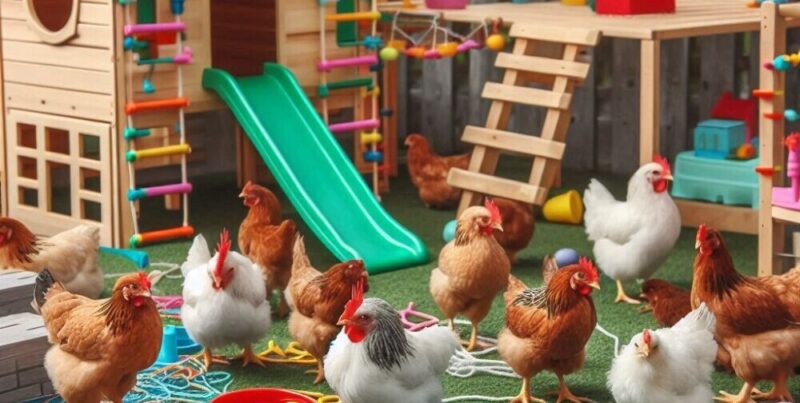
Chickens aren’t just machines—these friends have complex needs that we often overlook. Providing enrichment is crucial to their overall well-being, both mentally and physically, especially when confined to the coop.
Think about it: Just like people, chickens get bored too. Without the right kind of stimulation, we’re talking about a serious case of the doldrums for your backyard flock. Mental and physical activities do more than just keep chickens occupied; they’re vital for health, happiness, and reducing stress.
Incorporating chicken enrichment techniques ensures they engage in natural behaviors, keeping their instincts sharp. Whether it’s allowing them to forage or giving them perches to jump on, these activities are essential for a thriving flock.
By prioritizing chicken enrichment, you’re not just feeding or housing them. You’re giving your chickens a fulfilling life, which they absolutely deserve.
Understanding Chicken Enrichment
Chicken enrichment is all about creating an environment where your birds can naturally express themselves. It’s not just tossing a toy into the coop, but a holistic approach to their lifestyle. This concept caters to their basic instincts—scratching, foraging, and perching—to make sure they’re mentally and physically fit.
In more natural settings, chickens roam around, pecking and scratching at the ground. That’s their nature, right? Enrichment lets them channel these instincts, which are essential for their mental stimulation and overall happiness. It’s like giving them the world to explore, even if it’s just contained in your backyard.
Enrichment involves providing opportunities that mimic what chickens would experience in the wild. This might include varied heights to perch on for a better view of their surroundings or even food hidden under a layer of straw. Such activities engage their brain, keeping it sharp and active.
Think of enrichment as the chicken version of a balanced diet. They need a mix of cognitive and physical challenges to ensure they’re not just laying eggs but living their best lives. Reviewing your setup and adding enrichment options crafted for her needs can significantly boost your chickens’ well-being.
The Perks of Enriching Your Chickens
When chickens get bored, they might resort to some nasty habits, like pecking at each other or pulling feathers out. These behaviors don’t just harm the birds being picked on—they stress the whole flock.
Offering boredom busters like toys and different foraging opportunities can work wonders in nipping these problems in the bud.
Physical activities encouraged by enrichment go beyond fun. They’re crucial for exercise, which helps manage weight—nobody wants an overweight bird struggling with health issues. Encouraging movement through activities like exploring different surfaces or scattering feed around the yard keeps them agile and healthy.
Mental stimulation is key in ensuring your chickens don’t just go through the motions of each day. By keeping their noggins busy with various challenges, you help them maintain a sharp mind. Things like puzzle feeders or toys to find and peck at can do the trick, letting your chickens reveal their inner smarty-pants.
Remember, enrichment isn’t a one-size-fits-all. Every flock is different, so taking time to understand what particular activities they respond to best will pay off huge dividends in terms of their well-being. Observing, adjusting, and being patient is the name of the game.
Different Forms of Chicken Enrichment
All for fun and fun for all with this mind-stimulating array of chicken toys. Add them to your chicken coop and let the good times roll.
Mixing up the enrichment activities for your chickens isn’t just about keeping things fresh—it’s about catering to various aspects of their natural behavior. Let’s look into what kinds you can offer.
- Foraging enrichment is a staple. Chickens love to scratch around for food, so why not make them work a bit for their treats? Something as simple as scattering feed around their run or hanging veggies for them to peck at can mimic their natural foraging instincts. Treat balls are also a great addition. These activities not only stimulate their minds but also keep them moving.
- Physical enrichment doesn’t have to be complicated either. Providing perches, ladders, and swings adds new dimensions to their environment. Chickens enjoy a change in scenery and thrive with activities that encourage them to use different muscles.
- Social enrichment recognizes that chickens are social creatures. Introducing new flock members or setting up situations that require them to interact keeps the coop dynamics interesting. Observing how they bond and establish pecking orders is all a part of it.
- Lastly, sensory enrichment introduces an array of new experiences. Try adding mirrors, colored objects, or even items that make noise. These not only pique their curiosity but also engage their senses, providing an all-around enriching experience. Mixing these up ensures your chickens live full and varied lives.
The key is to observe what your flock enjoys the most and adjust accordingly. Sometimes, it’s trial and error until you hit the jackpot with the right combination of enrichments.
DIY Chicken Enrichment Projects
Creating your own chicken enrichment toys is not only budget-friendly but also a great way to personalize what your flock loves. With a little creativity and some common household items, you can keep your chickens entertained for hours.
One straightforward DIY project is making treat dispensers. Grab some old plastic bottles, poke a few holes, fill them with your chickens’ favorite snacks, and let them peck away. It’s satisfying to see them figure out how to get the treats, and it helps sharpen their problem-solving skills.
Upcycling is another smart approach. Look around your home for materials you can repurpose into chicken entertainment. Empty cereal boxes can become puzzle boxes, while old balls might make interesting pecking toys.
Seasonal treats also add a bit of fun variety. Frozen fruit in the summertime can double as both a treat and a way to keep cool. When fall rolls around, a pile of leaves provides a new texture and a change of scenery, giving them something new to scratch and explore.
The beauty of DIY enrichment is that it’s adaptable. Not every idea might be a hit with your flock the first time, but by observing and tweaking, you’ll find what brings joy to your chickens. Plus, it keeps things fun for you as their caretaker.
Chickens are curious. Anything new you add to the coop will be carefully scrutinized by all in attendance.
Getting Started with Chicken Enrichment in Your Flock
Introducing new enrichment activities to your flock is all about balance and timing. Too much change at once can be overwhelming, so start small. Begin by adding one new item or activity to their environment and see how your chickens react.
Monitor the flock’s interactions. If they seem stressed or uninterested, it might be a sign that the new addition isn’t quite right or needs a bit of tweaking. On the other hand, if you notice increased activity or even just relaxed clucking, you’re on the right track.
Gradually layer in different types of enrichment, mixing it up between foraging, physical, and sensory options. This ensures that you’re covering various aspects of their needs without any single activity losing its appeal too quickly.
Keeping an eye on your chickens’ behavior is crucial. Look for signs of happiness like active foraging, dust bathing, or even a bit of gentle clucking. These behaviors often indicate that your flock is engaged and content. Reduced aggression and less feather pecking also show that your enrichment strategies are working well.
Approaching enrichment as an ongoing process rather than a one-off task stands to benefit both you and your chickens immensely. Your flock thrives on variety, and by continually observing and adjusting, you’ll give them nothing short of a fulfilling, happy life.
Enjoy!
Dave

Chickenmethod.com


